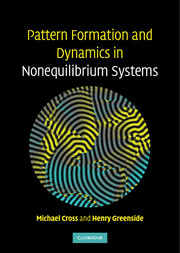Book contents
- Frontmatter
- Contents
- Preface
- 1 Introduction
- 2 Linear instability: basics
- 3 Linear instability: applications
- 4 Nonlinear states
- 5 Models
- 6 One-dimensional amplitude equation
- 7 Amplitude equations for two-dimensional patterns
- 8 Defects and fronts
- 9 Patterns far from threshold
- 10 Oscillatory patterns
- 11 Excitable media
- 12 Numerical methods
- Appendix 1 Elementary bifurcation theory
- Appendix 2 Multiple-scales perturbation theory
- Glossary
- References
- Index
1 - Introduction
Published online by Cambridge University Press: 05 August 2012
- Frontmatter
- Contents
- Preface
- 1 Introduction
- 2 Linear instability: basics
- 3 Linear instability: applications
- 4 Nonlinear states
- 5 Models
- 6 One-dimensional amplitude equation
- 7 Amplitude equations for two-dimensional patterns
- 8 Defects and fronts
- 9 Patterns far from threshold
- 10 Oscillatory patterns
- 11 Excitable media
- 12 Numerical methods
- Appendix 1 Elementary bifurcation theory
- Appendix 2 Multiple-scales perturbation theory
- Glossary
- References
- Index
Summary
In this opening chapter, we give an informal and qualitative overview – a pep talk – to help you appreciate why sustained nonequilibrium systems are so interesting and worthy of study.
We begin in Section 1.1 by discussing the big picture of how the Universe is filled with nonequilibrium systems of many different kinds, a consequence of the fact that the Universe had a beginning and has not yet stopped evolving. A profound and important question is then to understand how the observed richness of structure in the Universe arises from the property of not being in thermodynamic equilibrium. In Section 1.2, a particularly well studied nonequilibrium system, Rayleigh–Bénard convection, is introduced to establish some vocabulary and insight regarding what is a nonequilibrium system. Next, in Section 1.3, we extend our discussion to representative examples of nonequilibrium patterns in nature and in the laboratory, to illustrate the great diversity of such patterns and to provide some concrete examples to think about. These examples serve to motivate some of the central questions that are discussed throughout the book, e.g. spatially dependent instabilities, wave number selection, pattern formation, and spatiotemporal chaos. The humble desktop-sized experiments discussed in this section, together with theory and simulations relating to them, can also be regarded as the real current battleground for understanding nonequilibrium systems since there is a chance to compare theory with experiment quantitatively.
Information
- Type
- Chapter
- Information
- Publisher: Cambridge University PressPrint publication year: 2009
